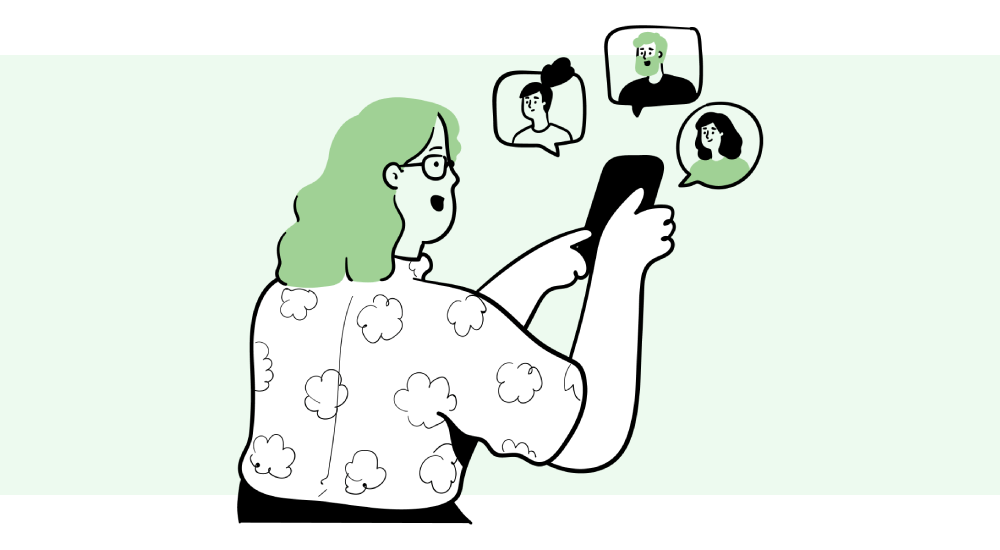Do you want to truly understand who is buying your product or service, and the how and why they are buying it? Then you want to create ideal customer personas. What are those? A customer persona is a fictional representation of your ideal customer. In this article, we will discuss how to create these personas for your business, and ensure they are effective and useful for your marketing.
No doubt you have an idea of what your business does or what problems it solves, however you might not know the best way to target that message. One of the most important ways to get things rolling is by knowing as much as you can about your ideal customer. To do that, you need to be developing target customer personas.
- What is a customer persona?
- Why customer personas are important
- How to create ideal customer personas
- What should go in your customer persona?
- Demographics
- Identifying your customer’s goals and struggles
- Needs and wants
- Personality traits
- Where and how to gain their interest
- Understanding how they buy
- How to use customer personas for marketing
Let’s now dive in and learn more!
What is a customer persona?
As I’ve mentioned, a customer persona is a fictional representation of your ideal customer. These personas will give you insights into how customers think and feel about your business or brand, so you can adjust messaging to better reach them.
Personas are a representation of an individual that your business can use to understand how they behave, what are their key goals, and what their motivations are.
These fictional representations of ideal customers are an essential tool for understanding your customer base, and a great way for your business to determine the types of marketing strategies and targeting you should use to best reach them.
They can also be used to help you answer questions such as who is visiting my website, why are they interested in my products, and how can I improve my customer service?
Why customer personas are important
Before we get into the nitty-gritty of how to create effective customer personas, it’s important to address why creating them is so crucial. A persona is a representation of who your ideal customers are and what they want out of your product or service.
It’s an opportunity to understand the mindset of your customers by observing their buying habits, preferences, and needs in order to craft messaging that connects with them.
By creating personas, you will receive insights into how your customers think and feel about your business that can help you target your marketing efforts more effectively.
Customer personas can also provide insight into how customers buy from your business. You might find that some personas prefer face-to-face interactions while others only buy online. This can help you determine if a physical store is the best place to sell or market to those customers.
Customer personas also allow you to create better messaging for those who prefer one-on-one interactions versus digital interactions (like social media ads).
For example, you might see that some people prefer email over social media for customer service inquiries, so you could tailor email campaigns accordingly in order to reach them more effectively.
There are many benefits when you create a customer persona. One of the most important reasons is that it will help you understand your customers better.
By creating a customer persona, you can learn more about certain parts of your business or industry. You can use these personas to identify trends or problems in your customer service and marketing efforts.
Personas make it easy for marketers to identify what type of customers they’re trying to reach, what their interests are, and how they’re using your products once they have them.
This helps businesses tailor their messages so they speak to their specific audience and don’t fall into the trap of talking at everyone in generalities.

Customer Persona: Mary Jones
Example Persona: Mary Jones
Location: London, United Kingdom
Education: MBA
Works: Financial analyst, major finance company
Income: $44,000 GBP
Goals: Find partner, career progression.
Interests: gardening, social media, action movies, romance books.
Story: Mary is 32 years old, university educated and lives in the inner city of London. She is single, and has one cat. Mary works very long hours, and in her downtime, will watch streaming TV and regular video calls with her close friends.
Mary is an avid LinkedIn and Facebook user, and has a new Apple MacBook.
How to create ideal customer personas
Creating customer personas is one of the most common ways to identify your ideal customers.
In order to develop effective customer personas, you need three distinct pieces: an understanding of who your ideal customer is, what they want from a product or service, and the story behind their buying habits.
Before you begin, you’ll want to make sure you have a clear idea of who your target audience is by identifying their unique characteristics.
The first step to creating a customer persona is to create a list of crucial questions. These questions will help you understand your customers better, which in turn will help improve your business.
For example, if you want to know who’s visiting your website, ask yourself what are the most important aspects of their experience? What do they like about your website? What types of products or services are they interested in? What are the key features that influenced them to visit your site?
To create a customer persona, ask yourself these questions:
- Who is my ideal customer?
- What does my ideal customer think about?
- What are the pain points that my ideal customer is facing?
- What type of content do they want to see from me or my business?
- What makes them feel like they’re in control with me?
The more specific these questions are, the easier it will be for you to create an accurate customer persona. Once you have a list of questions, it’s time to start thinking about how you can answer them.
Here are some different options for answering those questions:
- Interviewing: You could interview current customers or potential customers. This allows you to see how they use your website and product/service on a regular basis and ask them what they think about certain aspects of their experience.
- Surveys: You can also conduct surveys with previous or potential customers so you can see what they find most valuable about your brand as well as get feedback on how they feel about certain aspects of their experience with your business.
What should go in your customer persona?
A customer persona is a fictional representation of your ideal customer. It helps you understand who is buying your product and how they buy it.
When you create ideal customer personas, you should consider what makes them unique and different from other customers. What do they care about? What are their goals? What do they think?
You should also outline the key attributes of these consumers and how they would describe themselves. These attributes can help people recognise your brand or business in the marketplace.
One way to create personas is to start with one attribute that you know will have a lot of impact on your business. For instance, if you sell board games, then perhaps one of the most relevant attributes may be whether or not someone has kids.
They might also have an interest in learning new things or playing games with friends and family around the table together. You could create personas for those types of customers as well as others who don’t fit that description however still want to play board games with other people at home.
In order to make sure that each persona is complete, include information about how many hours each day they spend playing games, where they live, what makes them happy-and anything else that matters to your business!
Demographics
When you create ideal customer personas, you will want to know about the demographics of your audience. This means understanding what demographic information is important to your business.
Start with the basics, things that we can pretty much guess. These include;
- Gender
- Age
- Location
- Education
- Marital status
For example, if you are in the fashion industry, you may want to know about their age and gender. If you are a technology company, you may want to know about their income levels so that your marketing materials can be tailored accordingly.
Additionally, knowing what kind of budget they have is important as well. For example, if they are married with children, it would be important for your marketing materials to not feature any images of singles or women who aren’t wearing makeup.

Customer Persona: Stephen O’Connor
Example Persona: Stephen O’Connor
Location: Phoenix, Arizona
Education: Masters, electrical engineering
Works: Electrical engineer
Income: $87,000
Goals: Buy own home, have children, be respected among peers.
Interests: Camping, motorcycling, computer gaming.
Story: Stephen is 48 years old, and has a Masters in electrical engineering. He is married with three children, which he spends plenty of time with. When not parenting, he spends his spare time tinkering on a few motorcycle projects or playing computer games.
Stephen has all the latest technology at home, and uses LinkedIn and YouTube the most.
Identifying your customer’s goals and struggles
The first step when you create ideal customer personas, is to identify your customer’s goals and struggles.
Many businesses create customer personas based on their ideal online customers. They use these personas as a way of understanding how they can best market to this specific audience, because they believe that their ideal audience will most likely be similar to the people who visit their website.
This is problematic in that this type of persona might not accurately represent your business or its customers. A better approach is to create personas based off of behaviours, demographic data, and other factors that are directly applicable to your business.
For example, if you ran an art gallery in Sydney, you would probably want to create personas for both local residents and international visitors visiting from abroad since these two groups have different needs and buying habits.
Persona creation can also be done by asking questions to people in your organisation about what you should consider when developing a customer persona for your website or business.
This process can be done informally through brainstorming sessions with employees or more formally through surveys with potential customers.
Needs and wants
Then you must determine what the needs of your customers are. What are the problems they have that you can solve? What are their wants? How do they feel about your company and its products?
Once you’ve developed an understanding of their needs and wants, create a list of these things. Think about what’s important to them in terms of your product or service. Next, think about how they may react to messaging you will use once you have determined this information.
Now that you know who your customer is and what they care about, it’s time to create ideal customer personas and flesh them out further.
Personality traits
Personality traits are how your audience behave or think, and they help you hone in on the right language and tone for each persona.
A customer persona helps you understand who is buying your product and how they buy it. These personas will give you insights into how customers think and feel about your company, so you can adjust messaging to better reach them.
In order to determine personality types, think about what type of behaviours, values and beliefs are most important to your company’s target market. For example, if you sell health products, such as diet pills or vitamins, make sure to consider personality traits like being adventurous or passionate.
Some personality traits that can be used in profiles include:
- Age and gender
- Their education level
- Family situation (single, parents with children)
- Occupation
- Income level
- Location
- Interests
Any other information that you can confidently add to these personas helps.
Customer Persona: Jana Wan
Example Persona: Jana Wan
Location: Melbourne, Australia
Education: Studying visual arts at University
Works: Student, part time barista
Income: $20,000
Goals: complete university, develop artist career, find stable work
Interests: visual arts, action movies, travel, eating out
Story: Jana moved to Australia with her parents when she was only 5, and has grown up in Melbourne. She finished high school last year, and is now at University on a scholarship for visual arts. On weekends and a few evenings a week, she works at a local cafe.
Jana spends time every day on Instagram, and watches plenty of art related tutorials on YouTube.
Where and how to gain their interest
What is the level of interest in the product? Is it a high-interest product or do people need convincing before they try it? Is there a certain demographic that uses a specific marketing channel more?
It’s not just online either. We need to think billboards, radio, TV, Instagram, Facebook, blog posts and more.
Understanding how they buy
The most popular method of creating a customer persona is to conduct surveys and interviews with your customers. This often takes the form of quantitative and qualitative research, in which participants are asked questions about themselves and their buying behaviours.
These questions can range from what they want in an ideal experience to what they’re looking for in terms of price, delivery, etc. The key is being able to draw conclusions from the information gathered and create a customer persona that truly reflects the needs of your current customers.
Customer personas can be created as broad strokes or detailed profiles. For instance, you could create a generalised customer persona for your entire audience or you could use it to profile specific groups, like a millennial-focused customer persona.
The latter might include information on the industry the person is working in and what their interests are so you can tailor content accordingly.
You don’t just create ideal customer personas, and then forget about them either. These customer personas should be updated regularly so that they remain relevant and provide accurate insights into your business’s customers.
How to use customer personas for marketing
Customer personas are idealised versions of your customers. They help you understand how a customer feels about your brand so you can develop the best messaging and marketing campaigns to reach them.
You’ll need to consider which type of persona will work best for your business. If you have one or more products, it may be useful to create individual customer personas for each product.
If you have multiple categories of products, it might make sense to create one customer persona that represents all the different aspects of your company.
The key is finding a way to represent your customers that is specific and unique. This will help you better understand who they are and what they want.
So in future, when you are creating a marketing campaign, it’s not just gut feel, but rather you are targeting specific personas. Say you are selling visual arts materials; knowing more about Jana and what she is interested in will help direct the imagery and text that you use.
It’s pointless promoting on Twitter if Jana and her type aren’t using the platform. Looking at her persona (above), you would be better spent using Instagram or YouTube to deliver content.
Conclusion
By investing your time and efforts into creating target customer personas, you will be helping craft better marketing, which will enable your business to grow.
To do that, you need to understand all of which we covered, to recap are;
- What is a customer persona?
- Why customer personas are important
- How to create ideal customer personas
- What should go in your customer persona?
- Demographics
- Identifying your customer’s goals and struggles
- Needs and wants
- Personality traits
- Where and how to gain their interest
- Understanding how they buy
- How to use customer personas for marketing
Never forget that your target customer personas should be updated regularly, as the marketplace and your offerings change and adapt.
This will allow your marketing to remain relevant and provide engaging messaging to your ideal customers.

 Entrepreneur,
Entrepreneur, 